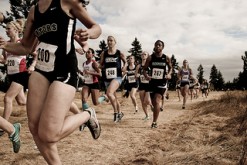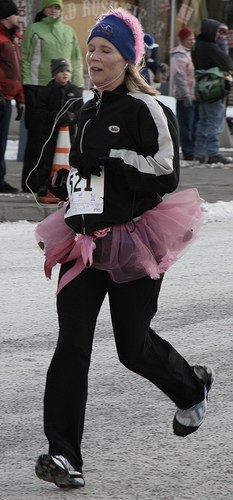
My boyfriend is the captain of the cross country team.
He goes running every morning at 7:15, attends practice for two to three hours in the afternoon, and goes on “long-runs” every Sunday, logging between 15 and 18 miles that day alone.
I am a dancer. I start to hyperventilate the second I even begin to consider running more than a mile.
I don’t need to run too, do I? Hanging around my boyfriend, I’ve started to realize there must be some appeal, some benefit to running. After all, the thought of being stuck in dance classes all day is just as hive-inducing for him as it is for me to think about running. So I’m asking, can dancing and running live in harmony?
There are some fundamental differences between ballet training and training for a marathon…
The most obvious difference is that the training for one requires you to run long distances over and over to build stamina while the other requires you to perform isolated movements over and over again to build stamina.
Wait though; I did just say “build stamina” in both of those examples. In her article Dancing Vs. Running: The Difference In Muscle Tone, Burr Leonard explains that in running,
“Each step by one leg gives a brief rest to the other…Running is thereby highly efficient at conserving energy, affording leg muscles built-in instants of regenerative rest so that they are never completely exhausted. Put a runner’s quads or hamstrings in a situation that calls for sustained muscle tension – or strength work — and they experience quick fatigue. Dancers, on the other hand, train to hold sustained positions such as plies, extensions, and balances.”
Runners win when it comes to conserving energy and using it in short bursts whereas dancers take the cake when it comes to holding a muscle in a position for a prolonged time period of time.
Are there actual differences between the muscles of a professional ballerina and a marathon runner?
Well, yes. The hips of the marathon runner will be tighter than the hips of the ballerina. Running also favors the use of some muscles over others, as I mentioned above. Still, some dance forms require more cardiovascular endurance than others. But are these differences as present in someone who dances 4 hours a week and runs 4 hours a week? Maybe not so much.
Sally Fitt emphasizes in her book, Dance Kinesiology
“Cardiorespiratory fitness is just as important to dancers as it is to athletes, but dance training seldom has paid as much attention to it. While some choreographers are noted for the vigorous demands they place on dancers, it is rare to find sufficient preconditioning for those demands in dance classes. High levels of cardiorespiratory fitness delay the onset of fatigue and accelerate the recovery rate from vigorous exercise.”

There are many instances where running can be an effective cross training activity. As Lauren Warnecke explained for DanceAdvantage in her article on the benefits of cross-training, “Your body can only benefit from introducing alternative forms of exercise, given you aren’t fatigued or over-training.”
My conclusions
The key is using moderation when exploring the two together.
Eric Franklin seems to agree in his book, Conditioning for Dance.
“As a dancer, you usually do not need the maximum strength of a weightlifter, just as you don’t need the muscular endurance specific to a marathon runner. However, including an aerobic workout three times a week can be beneficial, especially if you pay attention to alignment and use imagery to move with sound biomechanics .”
There are obvious benefits that cardiovascular fitness has for the dancer, but maybe tagging along for my boyfriend’s 18 mile Sunday runs won’t help my plié.
Assuming I am staying safe, adding running into my routine will not hurt my dance life. In fact, it might even help!
Going into a new week of dance classes, I’m thinking a lot about how I view these two activities.
For further reading, here is a link to Jen Stahl’s article “Running for Dancers” that expands on some of the ideas I’ve explored and offers tips on how to run when you are a dancer (like me!).
What can I pull from one to help me with the other?
What experiences have you had balancing dancing and running?
What ways have you found to effectively combine the two?
We’d love to hear from you in the comments!
Alissa Anderson is a lifelong resident of Jamestown, New York. Currently in her senior year at Beloit College in Beloit, Wisconsin, she is majoring Dance and Comparative Literature. Her choreography has been featured in the Beloit College December Dance Workshops during Fall 2011 and 2012. Additionally, she studies both Spanish and Portuguese and spent a semester abroad studying environmental sciences in Juiz de Fora, Minas Gerais, Brazil. After graduation, she plans to pursue a career writing for the arts and to continue her study of the Portuguese language.

Dance Advantage welcomes guest posts from other dance teachers, students, parents, professionals, or those knowledgeable in related fields. If you are interested in having your article published at Dance Advantage, please see the following info on submitting a guest post. Read posts from guest contributors.



